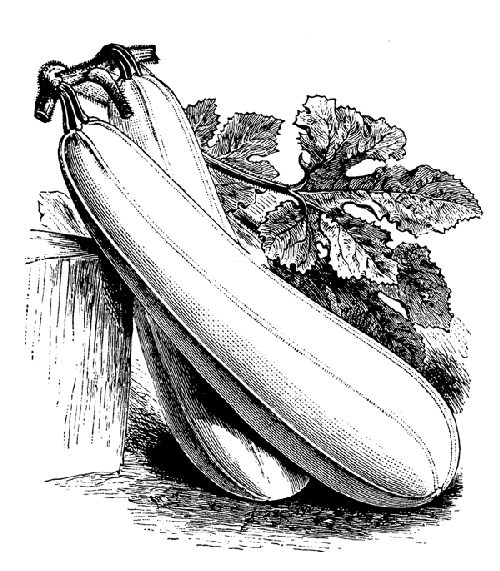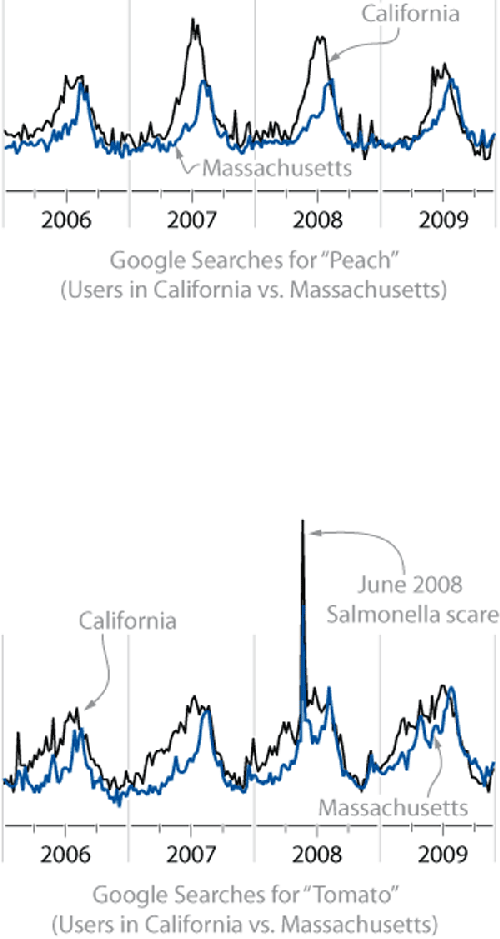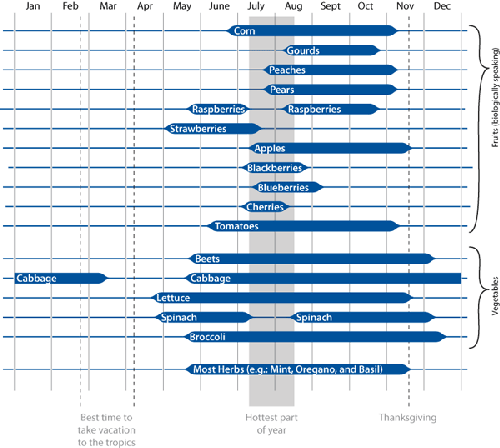Cooking “within season” means using only those
ingredients that have good, fresh flavor and are ripe. Restricting yourself to ingredients
that are in season in your region is a great way of creating constant challenges and
exposing yourself to new ingredients. And because in-season ingredients tend to be of higher
quality and pack more of a flavor punch, it’s that much easier to make the resulting dishes
taste good. Next time you’re at the grocery store, take note of what new fruits and
vegetables have arrived and what is in dwindling supply.Of course, not every ingredient in a dish is a “seasonal” ingredient. Cellar onions,
storage apples, and pantry goods such as rice, flour, and beans are year-round staples and
fair game. What is off-limits with this approach are those foods that are outside their
growing season for where you live. Put another way, don’t try making grilled peaches in
February. Even if you can get a peach in February, it won’t have the same flavor as a
mid-summer peach, so it will invariably taste flat. Even if those peaches shipped from Chile
taste okay, they won’t be as good as the local in-season peaches, because they have to be of
a variety that favors shipping durability and disease resistance over taste and texture.
(Unless you happen to live in Chile.)
One of the perks of using in-season ingredients, besides the quality, is that the
abundance of the in-season produce generally means lower prices, too, as the
supply-and-demand curves change. Grocery stores have to figure out how to sell all those
zucchinis when they come up for harvest, and running specials is one of the standard ways of
moving product. The same challenge applies even more if you’re growing your own fruits and
vegetables, because a home garden can produce an abundance over a short period of time. If
you figure out what to do with the 100 pounds of zucchini that all come ready in late
summer, I know plenty of people who would like to hear it!
Note:
In-season, local foods have the advantage of typically being fresher than their
conventional counterparts, which is especially important for flavor in highly perishable
foods such as heirloom tomatoes and fresh seafood. Local isn’t always better, though. For
example, if you live in a northern climate, you might find that produce such as radishes
from traditional farms located where it gets hotter might taste better.

First they say farm-raised salmon is better, then it’s
wild salmon. Or the blogs light up with posts about how many metric tons of greenhouse
gases or gallons of water are associated with producing an average cheeseburger. Then
there’s the whole “local food” movement wanting to help with reducing our collective
carbon footprint. What’s an environmentally conscious geek to do? It depends. How much are you willing to give up? Let’s start with the good news, with the greenest of the green: your veggies. Locally
grown veggies combined with a minimum of transportation and sold unpackaged are about as
good as you can get for the environment, and they’re about as good as you can get for
yourself. Look for a farmers’ market in the summer (or if you’re lucky enough to live in
California, year-round). Farmers’ markets are a great way to really understand where your
food is coming from. Plus, your local economy will thank you. You can also subscribe to a CSA (community-supported agriculture) share, where every
week or two you receive a box of local and seasonal produce. It’s a great way to challenge
yourself in the kitchen, because invariably something unfamiliar will show up in your CSA
share, or you’ll find yourself with 10 pounds of spinach and be looking for something new
to do with it. Regardless of anything else, your mother was right: eat your veggies. (On a
personal note unrelated to the environment, I believe the typical American diet doesn’t
include enough veggies. Eat more veggies! More!) In the other corner, there are red meats like corn-fed beef. It’s environmentally
expensive to produce: the cow has to eat, and if fed corn (instead of grass), the corn has
to be grown, harvested, and processed. All this results in a higher carbon footprint per
pound of slaughtered meat than that of smaller animals like chickens. Then there’s the
fuel expended in transportation, along with the environmental impact of the packaging. By
some estimates, producing a pound of red meat creates, on average, four times the
greenhouse-gas emissions as a pound of poultry or fish. Regardless of where you fall on the spectrum between local-shopping vegan and
delighting in a ginormous bacon-wrapped slab of corn-fed beef, limiting consumption in
general is the best method for helping the environment. Choose foods that have lower
impact on the environment, and be mindful of wasted food. See the caveat below, but
current data suggests the total impact on the environment of consuming fish is less than
the impact of eating chicken and turkey, which likewise is more sustainable than pork,
which is in turn better for the environment than beef. This isn’t to say all red meats are bad. If that steak you’re cutting into came from a
locally raised, grass-fed cow, she might actually be playing a positive role in the
environment by converting the energy stored in grass into fertilizer (i.e., manure) for
other organisms to use. See Michael Pollan’s classic The Omnivore’s
Dilemma (Penguin) for more on this topic, but as a general rule, the more
legs it has, the “less good” it is for the environment. (By this logic, centipedes are
pure evil...) By most analyses, cutting the amount of red meat you consume is the easiest way to
make a positive impact on the environment. One friend of mine follows the “no-buy” policy:
he happily eats it, but won’t buy it. I’ve heard of others
following variants of Mark Bittman’s “vegan before 6″ diet: limiting consumption of meats
during the day but pigging out at dinner. With respect to fish, whether farm raised or wild-caught is better depends upon the
species of fish, so there’s no good general rule. There are issues with both types: some
methods of farm fishing generate pollutants or allow fish to escape and commingle with
wild species, while wild-caught contributes to the depletion of the ocean’s stocks, and
the impact of a global collapse in the fisheries from over-fishing is a very real threat
to the food supply to hundreds of millions. The biggest contribution you can make—at least on the dinner plate—is to avoid
wild-caught seafood of species that are overfished. The Monterey Bay Aquarium runs a great
service called “Seafood WATCH” that provides a list of “best,” “okay,” and “avoid”
species, updated frequently and broken out by geographic region of the country. |
Data from Google Trends showing search volumes for the terms “peach”
(left) and “tomato” (right) for California users and Massachusetts users. The growing
season in Massachusetts starts later and is much shorter than in California. There’s a
tight correlation of this with Google’s search volumes for those
terms.

If it’s the dead of winter and there’s a foot of snow on the ground (incidentally,
not the best time to eat out at restaurants specializing in local,
organic fare), finding produce with “good flavor” can be a real challenge. You will have to
work harder to produce flavors on par with those in summer meals. Working with the seasons
means adapting the menu. There’s a reason why classic French winter dishes like cassoulet
(traditionally made with beans and slow-cooked meats, but that description does
not do this amazing dish justice—I make mine with duck confit, bacon,
sausage, and beans, then slow roast it overnight) and coq au vin (stewed
chicken in wine) use cellar vegetables such as onions, carrots, turnips, and potatoes and
slow, long-cooking simmers to tenderize tougher cuts of meat. I can’t imagine eating
cassoulet mid-summer, let alone venting the heat generated from keeping the oven on for that
long. Yet in the dead of winter, nothing’s better.
Seasonality chart for fruits and vegetables in New England. Fruits have a
shorter season than vegetables, and only a few vegetables survive past the first
frost. Some plants can’t tolerate the hottest part of the year; others do best during
those times. If you live in the Bay Area or New York, see
http://www.localfoodswheel.com
for a nifty “what’s in season” wheel chart.

Consider the following three soups: gazpacho, butternut squash, and white bean and
garlic. The ingredients used in gazpacho and butternut squash soup are seasonal, so they
tend to be made in the summer and autumn, respectively (of course, modern agricultural
practices have greatly extended the availability of seasonal ingredients, and your climate
might be more temperate than the sources of these traditions). White bean and garlic soup,
on the other hand,
uses pantry goods that can be had at any time of year. Thus, it is traditionally thought of
as a winter soup, because it’s one of the few dishes that can be made that time of
year.